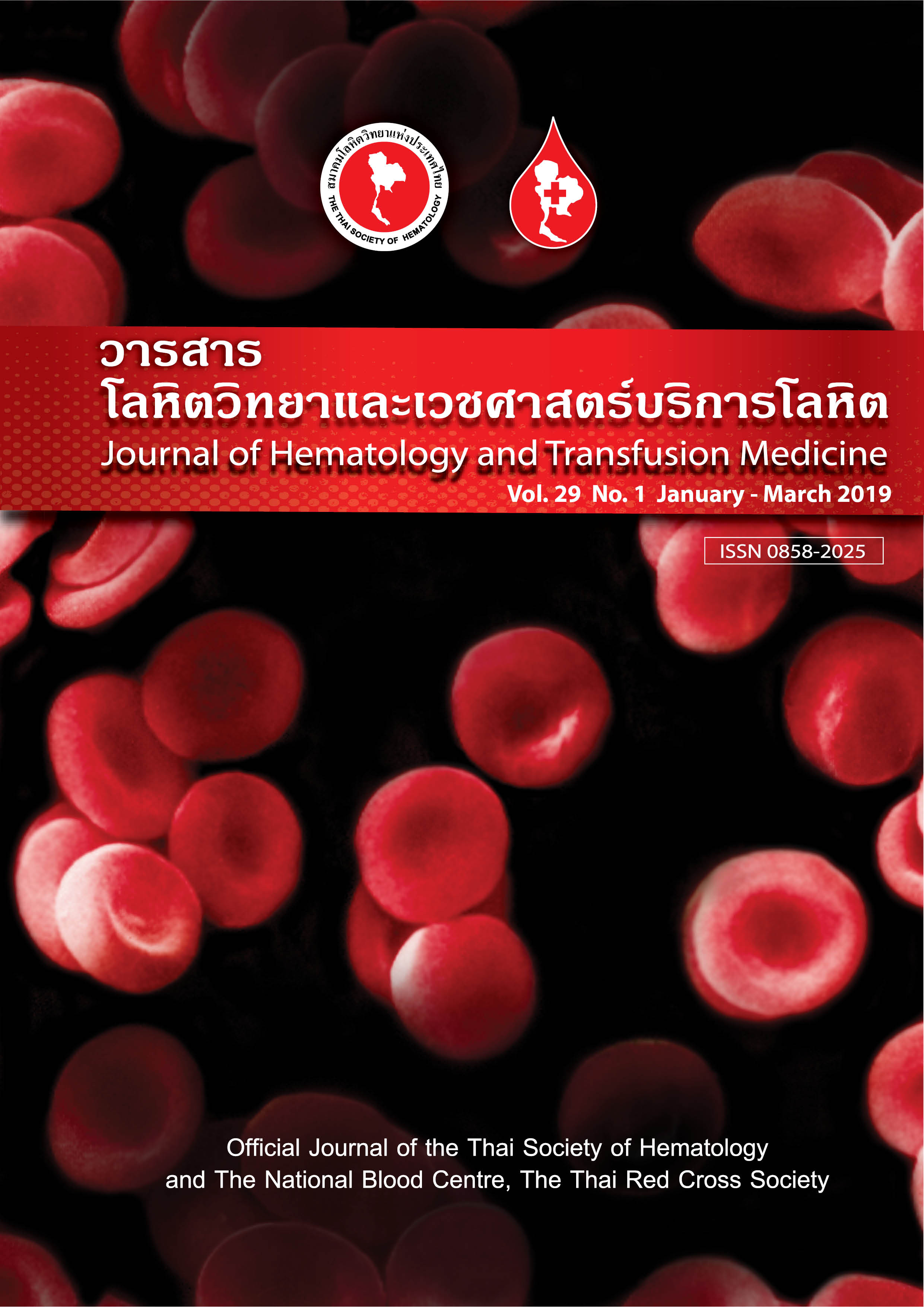การศึกษาภาวะพร่องธาตุเหล็กในผู้บริจาคเกล็ดเลือดชนิด single donor platelets (SDP)
Keywords:
Iron deficiency, Anemia, Serum ferritinAbstract
บทคัดย่อ
การบริจาคเกล็ดเลือดชนิด single donor platelets (SDP) อาจก่อให้เกิดภาวะพร่องธาตุเหล็กสะสม (iron deficiency) ซึ่งจำเป็นต้องมีแนวทางเพื่อเฝ้าระวังและดูแลผู้บริจาคอย่างเหมาะสม วัตถุประสงค์ เพื่อศึกษาความชุกและปัจจัยเสี่ยงของภาวะพร่องธาตุเหล็กสะสม ในผู้บริจาคเกล็ดเลือดชนิด single donor platelets (SDP) วัสดุและวิธีการ คัดเลือกผู้เข้าร่วมโครงการวิจัยโดยใช้เกณฑ์การบริจาคเกล็ดเลือดมากกว่าหรือเท่ากับ 7 ครั้ง ในระหว่างเดือนมกราคม ถึง ธันวาคม พ.ศ. 2557 ตามขั้นตอนการรับบริจาคเกล็ดเลือดปกติโดยบ่งชี้ภาวะโลหิตจางและภาวะพร่องธาตุเหล็กสะสมจากการตรวจ complete blood count (CBC), serum ferritin, serum iron และ transferrin saturation ผลการศึกษา พบว่าผู้บริจาคเกล็ดเลือดส่วนใหญ่เป็นเพศชาย 40 คน (ร้อยละ 83.3) เป็นเพศหญิง 8 คน (ร้อยละ 16.7) พบผู้บริจาคมีภาวะพร่องธาตุเหล็กสะสมจำนวน 8 ราย และมี 2 รายแสดงภาวะโลหิตจางจากภาวะพร่องธาตุเหล็กสะสม โดยพบว่าภาวะพร่องธาตุเหล็กสะสมมีความสัมพันธ์ กับความถี่ในการบริจาคมากกว่าหรือเท่ากับ 12 ครั้ง/ปี (p =0.013) และการรับประทานยาเสริมธาตุเหล็กไม่ครบตามปริมาณที่แนะนำ (p =0.014) สรุป ผู้บริจาคเกล็ดเลือดเกิดภาวะพร่องธาตุเหล็กสะสมได้หาก มีความถี่สูงในการบริจาคเกล็ดเลือดและไม่รับประทานยาเสริมธาตุเหล็กทดแทนหลังการบริจาค
Abstract:
Single donor platelets (SDP) donation may risk for iron deficiency. The donors therefore need appropriate monitoring and care plans. Objective: To determine the prevalence and risk factors of iron deficiency in SDP donors. Materials and Methods: SDP donors, who had more than or equal to 7 donations during January-December 2014, were enrolled. The iron deficiency status of the donors was determined by abnormal complete blood count (CBC), serum ferritin, serum iron, or transferrin saturation results. Results: The enrolled donors were 40 males (83.3%) and 8 females (16.7%). Eight donors were identified as iron deficiency and among them, two were iron deficiency with anemia. The prevalence of iron deficiency were related to the donations of more than or equal to 12 times/year (p=0.013) and incomplete iron supplementation (p=0.014). Conclusion: SDP donors, who had higher frequency of SDP donations, need close monitoring. Compliance to the iron supplementation after the donation should be emphasized
Downloads
References
2. National Blood Centre, Thai Red Cross Society. Standards for blood banks and transfusion services. 4thed. Bangkok: Udomsuksa; 2009.
3. FenwalTM Company. The manual of amicus cell separator. Bangkok: The company; 2009.
4. MundeeY. Blood and blood products. Bull Chiang Mai Assoc Med Sci. 2008;41:53-61.
5. World Health Organization. Iron deficiency anaemia assessment, prevention, and control: a guide for program managers. Geneva: WHO; 2001.
6. Beutler E, Hoffbrand AV, Cook JD. Iron deficiency and overload. Hematology, The Education Program. 2003;1:40-61.
7. Ongtilanont K, Jeanantajit I, Rodpradup N, Manomaicharern N, Thongou Ch, Chunakha B. The reaction of the blood donation at the National Blood Center, Thai Red Cross Society and Mobile Units. J Hematol Transfus Med. 2007;22:233-8...
8. Boontaveeyuwat N, Kwanbunjan K, Sittisingh U, Saereesuchart W, Chitplee S, Songchitsombon S. Iron bioavailability in Thai diets. J Med Assoc Thai. 2002;85:369-75.
9. Bryant BJ, Hopkins JA, Arceo SM, Leitman SF. Evaluation of low red blood cell mean corpuscular volume in an apheresis donor population. Transfusion. 2009;49:1971–6.
10. Alexander HD, Sherlock JP, Bharucha C. Red cell indices as predictors of iron depletion in blood donors. Clin Lab Haematol. 2000;22:253–8.
11. Radtke H, Tegtmeier J, Rocker L, Salama A, Kiesewetter H. Daily doses of 20mg of elemental iron compensate for iron loss in regular blood donors: a randomized, double-blind, placebo-controlled study. Transfusion. 2004;44:1427-32.
12. Phimal W. Pharmaceutical therapy in patients with anemia [Internet]. [cited 2016 April24]. Available from https://www.kpi.msu.ac.th/upload/ag_tor_ref_byval/ag_16_in_1.2.4_876(2555).pdf
13. Magnussen K, Bork N, Asmussen L. The effect of a standardized protocol for iron supplementation to blood donors low in hemoglobin concentration. Transfusion. 2008;48:749–54.
14. Page EA, Coppock JE, Harrison JF. Study of iron stores in regular plateletpheresis donors. Transfus Med. 2010;20:22–9.
15. Duggan F, O’Sullivan K, Power JP, Healy M, Murphy WG. Serum ferritin in plateletpheresis and whole blood donors. Transfus Apher Sci. 2016;55:159-63.
16. Furuta M, Shimizu T, Mizuno S, Kamiya T, Ozawa K, Nakase T, et al. Clinical evaluation of repeat apheresis donors in Japan. Vox Sang. 1999;77:17–23.
17. Nuchprayoon, I. Sukthawee, B. Nuchprayoon, T. Red cell indices and therapeutic trial of iron in diagnostic work-up for anemic Thai females. J Med Assoc Thai. 2003;86:160-9.
18. Kittikalayawong Y, Mongkolkan N, waiwijit U, Ongtilanont K, Nuchprayoon I. The iron supplementation in female blood donors who donate regularly at the National Blood Centre, Thai Red Cross Society. J Hematol Transfus Med. 2008;18:289-94.


